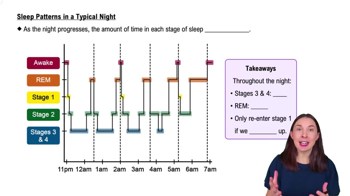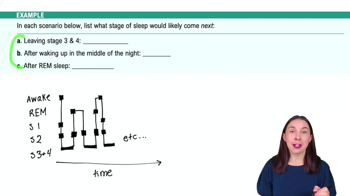Table of contents
- 1. Introduction to Psychology1h 43m
- 2. Psychology Research2h 20m
- 3. Biological Psychology2h 41m
- 4. Sensation and Perception28m
- 5. Consciousness and Sleep32m
- 6. Learning41m
- 7. Memory34m
- 8. Cognition37m
- 9. Emotion and Motivation35m
- 10. Developmental Psychology33m
- 11. Personality48m
- 12. Social Psychology41m
- 13. Stress and Health41m
- 14. Psychological Disorders44m
- 15. Treatment47m
5. Consciousness and Sleep
Sleep
Struggling with Psychology?
Join thousands of students who trust us to help them ace their exams!Watch the first videoMultiple Choice
The argument that people with spinal cord injuries can experience emotions without physical feedback from the sympathetic organs to the cortex initially seemed to support which emotional theory?
A
Common sense theory
B
James-Lange theory
C
Cognitive-mediational theory
D
Cannon-Bard theory
 Verified step by step guidance
Verified step by step guidance1
Begin by understanding the key components of each emotional theory mentioned in the problem.
The Common Sense Theory suggests that a stimulus leads to an emotion, which then leads to bodily arousal.
The James-Lange Theory posits that a stimulus leads to a physiological response, and the emotion is the result of perceiving this physiological change.
The Cognitive-Mediational Theory, proposed by Lazarus, suggests that a cognitive appraisal of a stimulus occurs first, leading to both an emotional and physiological response.
The Cannon-Bard Theory argues that emotions and physiological responses occur simultaneously and independently, which aligns with the idea that people with spinal cord injuries can still experience emotions without feedback from the body.

 3:25m
3:25mWatch next
Master Circadian Rhythms with a bite sized video explanation from Hannah Gordils
Start learningRelated Videos
Related Practice


































































































![Race, Genes and IQ Differences | Bret Weinstein [Mini Clip]](https://img.youtube.com/vi/IztL_m3pd70/mqdefault.jpg)



































































































